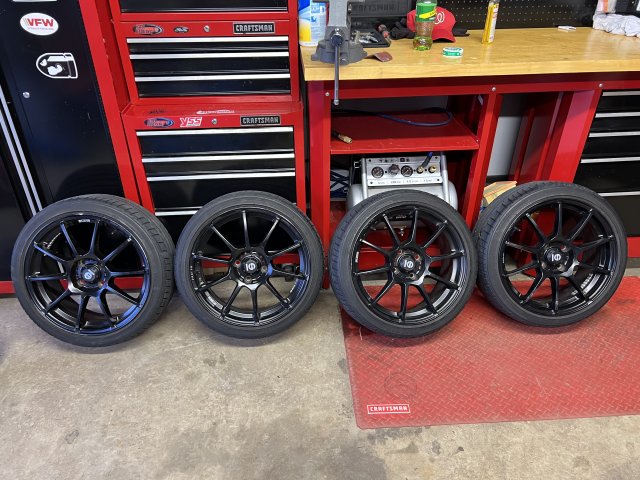I have generally heard that Sparcos are good wheels, and I like that rally look, but I would not want to get a discontinued model. If I bend or break one, I would want to have a readily available replacement. If I was going to buy a set of those now, I would buy five to have an extra one.
I think that going from a 17-in wheel to a 15-in one adds too much sidewall and compromises the best asset of the car, which is its quick and agile handling. That said, there are a lot of people on here with 15-in wheels who are happy with them.
Those tires strike me as too narrow and too low performance. I realize your car is going to be used as a daily driver/commuter, but I still would want to retain higher performance handling for the times when you can use it. Also, the tread width on that tire is only 5.7", too narrow to mount on a 7" wheel. That number is a more reliable number than section width, which is provided by the manufacturer and is subject to a range of tolerances.
I think that going from a 17-in wheel to a 15-in one adds too much sidewall and compromises the best asset of the car, which is its quick and agile handling. That said, there are a lot of people on here with 15-in wheels who are happy with them.
Those tires strike me as too narrow and too low performance. I realize your car is going to be used as a daily driver/commuter, but I still would want to retain higher performance handling for the times when you can use it. Also, the tread width on that tire is only 5.7", too narrow to mount on a 7" wheel. That number is a more reliable number than section width, which is provided by the manufacturer and is subject to a range of tolerances.
However I’d very much disagree on the 15” & 16” wheels.
It’s not really written anywhere, but I’ve noticed for some reason probably related to the spring rate of the inflated tire itself, modern radial tire sizes aimed around outright performance and grip tend to have sidewall heights between between about 95mm to 110mm with only few deviations as you get up around 295/305 width where sidewalls start to become shorter (around 85mm). It’s eerily almost universal across performance tires 200TW and lower, with only a sparse few outliers.
Part of it is probably that tires with sidewalls shorter than about 85mm require XL load ratings (and higher operating pressures for the same load), which means extra belts and correspondingly stiffer tire carcasses that don’t grip the road as well. And clearly tires with taller sidewalls tend to be too soft and squirmy.
Much wider tires probably have slightly softer rates just because of the overall width span. I don’t fully know why this is, maybe tire manufacturers know. (But they don’t tend to share)
In other car platforms, especially older ones that tended to come with more narrow balloon tires with very tall sidewalls, you see the more typical “plus sizing” of wheels, but they usually stop in that 95-110mm range and shorter sidewalls generally get considered only for “cosmetic” reasons.
The 17” wheels this car comes with are more or less too large to fit a decent tire on with the wheelwell space available, and the OEM tires are skinny rubber bands with 82mm XL reinforced sidewalls that by that criteria are too stiff. This can largely be explained by the fact that the Fiesta chassis has a lot of holdover design from the older Mk6 and Mazda 2, and there simply isn’t enough wheelwell space left to keep up with the modern automaker trend of steadily increasing wheel size, so Ford jumped through stupid hoops with skinny tires and mass dampers to sell huge 17” wheels on a Fiesta.
This might explain the tendency for track oriented Fiestas to shift to 16 or 15” tires which is completely opposite the typical trend, and to be honest completely baffled me when I first learned about it, until I paid attention to the actual sidewall height.
Tire width/section that fall in this range (applicable to our fitment - actual wheel size does not seem to be all that relevant)
195/55, 195/50
205/50, 205/55
215/45, 215/50
225/45, 225/50
235/45
245/40, 245/45
255/40, 255/45
Etc.
Some of those don’t exist in real tires, but otherwise you’ll notice most of the really common performance tire sizes in there (it reads a lot like a 200TW tire catalog)
Note this trend does fall apart a little for super wide pure and non-DOT race tires, but you also start to see stuff like Hoosiers start carrying the LL (light load) designations on them, meaning different tire construction and designs for even lower operating pressures.
If anyone does figure out an explanation other than tire spring rate and XL construction, please let me know!
Last edited:

